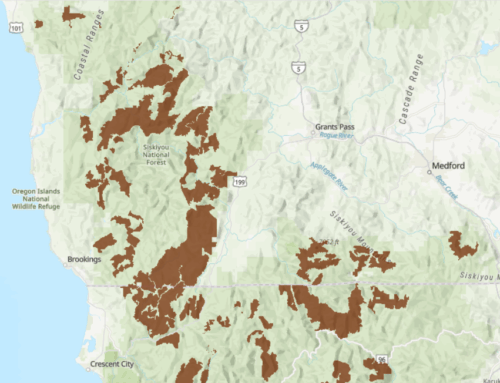The Conservation Column
by Pepper Trail
Happy New Year! Well, perhaps not as happy as we might wish, with Omicron still surging and just about complete deadlock in Washington. But there are still juncos and kinglets and waxwings and wigeons to lift our spirits! And plenty of conservation work to be done.
Let’s start off with a local issue. Ashland’s Imperatrice property east of 1-5 is a gem, with over 800 acres of open grass-land that is home to the largest population of Grasshopper Sparrows in southern Oregon – and perhaps the whole state. As many of you know, the property is currently leased for cattle grazing and closed to public access. But thanks to RVAS, the Southern Oregon Land Conservancy, and friends in Ashland city government, the cattle are only grazing the area below the irrigation ditch, away from the main areas used by the Grasshopper Sparrows. We have defeated various other destructive development ideas for the property over the years.
This fall, we learned of a new threat to the Imperatrice. The Rogue Valley Mountain Bike Association (RVMBA), as part of a proposal for a sprawling expansion of Ashland’s already extensive mountain bike trails, wants to put bike trails on the Imperatrice.
RVAS submitted a letter in opposition to this plan. Here is an excerpt, with links to the RVMBA proposals:
“It is the position of RVAS that the Imperatrice is no place for mechanized recreation. Quiet and contemplative activities are the only appropriate human uses of this property – and mountain biking, with its emphasis on speed and adrenaline, certainly does not qualify. The impacts of bikes speeding around even a single loop trail would extend far beyond the footprint of the trail, causing disturbance that would likely lead to the abandonment of the area by Grasshopper Sparrows.
The current proposal (at pp. 28-30 of: https://www.ashland.or.us/SIB/files/RVMBA_SustainableMountainBikeTrails.pdf) appears to focus on a loop trail encircling the property above the ditch, while also discussing a possible “dual slalom” track. More detail on the “dual slalom” concept can be found on pp. 14-22 of this document, as “2016 trails concept for Imperatrice”: https://www.ashland.or.us/SIB/files/APRC/2021/TrailsMasterPlanReview_CreatedNov1_21/SMP_options.pdf. That “concept” included a whole network of trails, which would fragment the Imperatrice habitat and spread disturbance to every corner of the property.
This “dual slalom” concept is a nightmare. The illustrations on pp. 18-22 of the “2016 trails concept” show a huge and ugly footprint, designed for large competitive events, with extensive areas for parking and spectators. Even if this was located below the ditch, such massive development would completely alter the character of the Imperatrice, permanently mar the Ashland viewshed, and preclude appropriate conservation-centered management of this unique property.”
At this point, this proposal seems unlikely to attract serious support. We will do all we can to make sure that stays true.
And here are updates on some of Audubon’s statewide priorities, from the Oregon Audubon Council:
Priority # 1 – Defense of federal lands and environmental laws
The change in administration allows the conservation community to move from defense to offense. There is significant damage to be repaired from the last four years as well as opportunity to advance new initiatives.
● Migratory Bird Treaty Act: The Biden Administration has reversed efforts to weaken the Migratory Bird Treaty Act by restoring incidental take provisions.
● Spotted Owl Critical Habitat: The Biden Administration has reversed efforts to weaken Northern Spotted Owl protections by restoring the vast majority of critical habitat designations that were removed under the Trump Administration.
● River Democracy Act: Kalmiopsis Audubon Society continues to help lead an effort to support passage of a law to protect the headwaters of several rivers in southwest Oregon from the threat of nickel strip mining—the Southwest Oregon Watershed and Salmon Protection Act— and is working with a coalition to designate more wild and scenic rivers in our region and all over Oregon.
● Double-crested Cormorants: Portland Audubon continues to explore litigation related to the EIS allowing the killing of more than 120,000 Double-crested Cormorants annually which could place the small western population at significant risk.
● Klamath Basin: Funding was secured by Sen Jeff Merkely for the Klamath Basin (>$160 million). It is not clear at this point how much of that money will go towards the refuge.
Priority #2: Klamath National Wildlife Refuge
● The Klamath faced one of the worst droughts on record in 2021 and it was anticipated that it would see one of the worst botulism outbreaks ever as a result in the Klamath. This followed a botulism outbreak in 2020 which killed an estimated 60,000 birds. However, a variety of factors which are still being analyzed resulted in minimal cases of botulism being documented in 2021. It is possible that the lack of water caused many birds to bypass the Klamath altogether on their Southern Migration.
● California Waterfowl Association was able to secure some water rights for the Klamath.
Priority #3: Malheur National Wildlife Refuge
● The refuge is advancing a new 6 year, $6 million OWEB grant which includes development and implementation of a strategy to restore Malheur Lake. One of the strategies being given serious consideration but which needs significant additional exploration is installing levees in the lake to break it into smaller more manageable units. Audubon has not taken a position on this approach but did raise significant concerns that need more investigation.
Priority #4: Forests
● Oregon Forest Practices Act (OFPA) Reform: After more than a year of negotiations, conservation and timber interests did reach agreement on expanding riparian protections on private forests managed under the Oregon Forest Practices Act. The agreements include expanding riparian buffers for fish and non-fish bearing streams, protections for steep slopes and debris channels, expanded road standards, improved culverts standards, and also improved protections for beaver. The next step is to advance legislation in the 2022 legislative session to codify the agreements. The Governor has made this her top legislative priority for 2022. The State will also seek approval of an Habitat Conservation Plan (HCP) within 6 years to cover salmon, steelhead and bull trout and five amphibian species. This represents the biggest advancement of OFPA in a couple of decades.
● Legislation is advancing in the 2022 legislative session which would create a new Elliott State Research Forest Authority under the State of Oregon with OSU managing (but not owning) the forest. The legislation put in place the new structure, a new board structure, accountability mechanisms, etc. Conservation groups are actively tracking this legislation including some Audubon chapters. Cascadia Wildlands, Coast Forest Watch OLCV, Oregon Wild, Wild Salmon Center, etc. are supporting advancing this legislation. Parallel work is also occurring to advance Elliott HCP and a Forest Management Plan. In general it is fair to say that after a number of bumps in the road, the Elliott process is effectively advancing for-ward with strong natural resource protections.
● Western Oregon Forests Habitat Conservation Plan: Several chapters are tracking the development of a Habitat Conservation Plan for the Tillamook and Clatsop State Forests, In the fall, the Board of Forestry voted to continue work on this plan which is supported by the conservation community. A draft HCP was released for comments in March. Work is currently underway on a Forest Management Plan.
So, lots of work being done to make this a happy new year for birds and other wildlife. Now, back to the juncos and king-lets and waxwings and wigeons!



Leave A Comment
You must be logged in to post a comment.